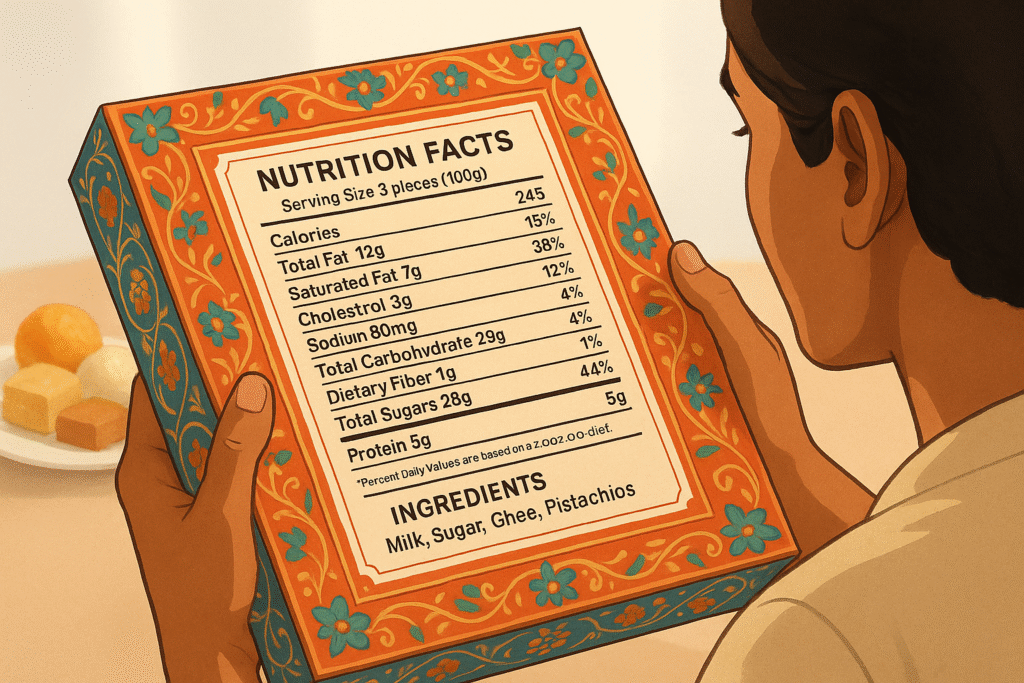When it comes to sweets, most of us focus on taste, freshness, and presentation. But have you ever paused to read the ingredients list on packaged sweets before buying them? In today’s fast-paced world, where convenience often wins over tradition, many sweets available in the market contain hidden preservatives, artificial colors, and additives that can affect not only the flavor but also your health.

At MishtiCue, we believe in delivering authentic Indian sweets like Alwar Kalakand across Pan India, made with pure ingredients, free from unnecessary preservatives. To help you make better choices, let’s explore why it’s crucial to check ingredients and how to identify preservatives in packaged mithai.
🍬 Why Ingredients Matter in Packaged Sweets
1. Health and Safety
Ingredients directly impact your health. Pure ghee, sugar, milk, and dry fruits are safe when consumed in moderation, but sweets laced with artificial flavors, synthetic colors, and chemical preservatives may cause long-term health issues like acidity, allergies, or digestive problems.
2. Transparency and Trust
When you buy packaged sweets, reading the ingredient list tells you whether the brand is being transparent. A trustworthy sweet maker will always list ingredients clearly without hiding behind vague terms like “permitted additives.”
3. Authenticity of Taste
Traditional sweets such as Alwar Kalakand, Ghewar, or Rasgulla rely on natural freshness. Preservatives often alter the taste, making the sweet feel too synthetic, unlike the authentic mithai you would enjoy at a local halwai.
🧾 Common Preservatives Used in Packaged Sweets
If you are a conscious consumer, here are some preservatives and additives you should watch out for:
- Sodium Benzoate (E211): Common in syrups and sugary sweets, but harmful in excess.
- Potassium Sorbate (E202): Prevents mold and yeast growth but can cause irritation for sensitive individuals.
- Sulphites (E220–E228): Often used in dried fruits or syrup-based sweets like gulab jamun.
- Artificial Colors (E102, E110, etc.): Brighten up sweets but can cause hyperactivity in children.
- Synthetic Flavor Enhancers: Imitate natural cardamom, rose, or saffron flavors instead of using real ingredients.
🕵️ How to Identify Preservatives in Packaged Mithai
- Read Labels Carefully – Look for “E-numbers,” chemical names, or vague terms like “permitted class II preservatives.”
- Check Shelf Life – Authentic Indian sweets usually have a short shelf life (2–7 days). If the package says “best before 3 months,” it’s likely loaded with preservatives.
- Observe Texture & Color – Too-bright sweets or unnaturally uniform textures can be a sign of artificial coloring and additives.
- Smell & Taste – If the sweet has a synthetic aftertaste instead of the natural aroma of ghee, milk, or saffron, it may not be authentic.
- Choose Trusted Brands – Go for brands that promise preservative-free preparation and deliver sweets fresh, like MishtiCue.
🌿 Why MishtiCue Focuses on Authenticity
At MishtiCue, we ensure that every sweet you order—from Alwar Kalakand to Rasgulla—is prepared using authentic recipes with natural ingredients. We don’t rely on harmful preservatives to extend shelf life. Instead, we focus on fresh production and careful packaging, so you enjoy mithai that tastes just like it would from your favorite sweet shop back home.
Our Pan-India delivery makes it possible to get authentic mithai without compromising on purity. Whether it’s for festivals, gifting, or simply indulging your sweet tooth, we bring you traditional Indian sweets you can trust.
❤️ The Takeaway
Sweets are meant to spread joy, not worries. By learning how to read labels and identify preservatives, you protect your health and enjoy sweets the way they are meant to be—fresh, authentic, and delicious.
When you choose MishtiCue, you don’t just buy sweets; you bring home authenticity, purity, and trust.
alwar kalakand, authentic indian sweets, buy sweets online india, indian mithai delivery, mishticue sweets, packaged sweets india, preservative free mithai, traditional indian mithai, types of indian sweets, why check ingredients in sweets

